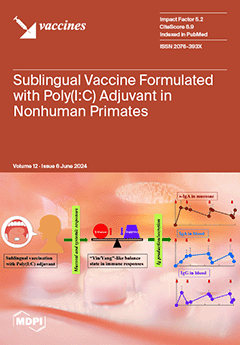Open AccessArticle
Field Trials of Live and Inactivated Camelpox Vaccines in Kazakhstan
by
Muratbay Mambetaliyev, Sanat Kilibayev, Marzhan Kenzhebaeva, Nuraiym Sarsenkulova, Shalkar Tabys, Aisulu Valiyeva, Dias Muzarap, Moldir Tuyskanova, Balzhan Myrzakhmetova, Nurkuisa Rametov, Aizhamal Sarbassova, Ryspek Nurgaziev, Aslan Kerimbayev, Shawn Babiuk and Kuandyk Zhugunissov
Cited by 1 | Viewed by 1161
Abstract
An outbreak of camelpox occurred in the Mangistau region of Kazakhstan in 2019. To control the outbreak of camelpox and to prevent its further spread to other regions, camels were vaccinated using live and inactivated camelpox vaccines produced in Kazakhstan. To evaluate the
[...] Read more.
An outbreak of camelpox occurred in the Mangistau region of Kazakhstan in 2019. To control the outbreak of camelpox and to prevent its further spread to other regions, camels were vaccinated using live and inactivated camelpox vaccines produced in Kazakhstan. To evaluate the efficacy of these camelpox vaccines in the field, vaccine trials used 172 camels on camel farms in the Beineu district. Of these, 132 camels were vaccinated using a live attenuated camelpox vaccine and 40 camels were vaccinated using an inactivated vaccine to observe immunogenicity and safety. The live vaccine was inoculated into camels by scarification at a dose of 5 × 10
4 EID
50, and the inactivated vaccine was injected intramuscularly at 5 mL twice, with an interval of 35 days. During the safety evaluation, camels administered either vaccine displayed no clinical signs of illness or any adverse effects. Post-vaccination seroconversion demonstrated that the live attenuated vaccine started to elicit antibody responses in some animals as early as day seven, while, by day 28, 99% of vaccinated camels responded. For camels immunized with the inactivated vaccine, seroconversion began on day 21 at low titers ranging from 1:2 to 1:4. Ninety days post vaccination, 77% of the camels demonstrated an immune response that was up to a titer of 1:16. The antibody response waned six months post vaccination in camels vaccinated with two types of vaccine. Nonetheless, both vaccines were 100% effective at preventing clinical disease in vaccinated camels during the camelpox outbreak. All unvaccinated camels became ill, with manifestations of clinical signs characteristic of camelpox. Following these successful field trials in Kazakhstan, a vaccination program for camels, to control camelpox using the domestically produced live attenuated camelpox vaccine, has started.
Full article
►▼
Show Figures






